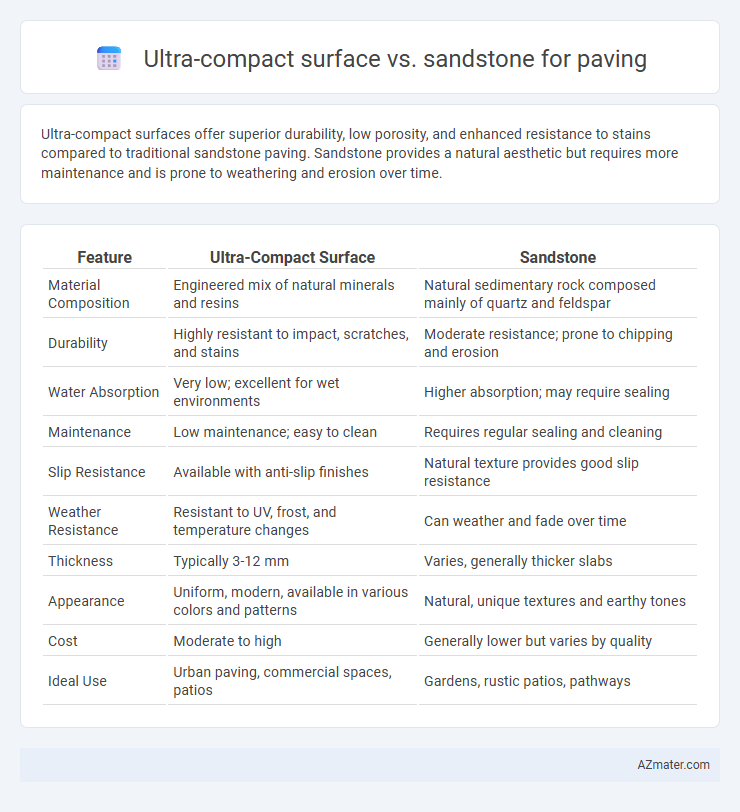Ultra-compact surfaces offer superior durability, low porosity, and enhanced resistance to stains compared to traditional sandstone paving. Sandstone provides a natural aesthetic but requires more maintenance and is prone to weathering and erosion over time.
Table of Comparison
| Feature | Ultra-Compact Surface | Sandstone |
|---|---|---|
| Material Composition | Engineered mix of natural minerals and resins | Natural sedimentary rock composed mainly of quartz and feldspar |
| Durability | Highly resistant to impact, scratches, and stains | Moderate resistance; prone to chipping and erosion |
| Water Absorption | Very low; excellent for wet environments | Higher absorption; may require sealing |
| Maintenance | Low maintenance; easy to clean | Requires regular sealing and cleaning |
| Slip Resistance | Available with anti-slip finishes | Natural texture provides good slip resistance |
| Weather Resistance | Resistant to UV, frost, and temperature changes | Can weather and fade over time |
| Thickness | Typically 3-12 mm | Varies, generally thicker slabs |
| Appearance | Uniform, modern, available in various colors and patterns | Natural, unique textures and earthy tones |
| Cost | Moderate to high | Generally lower but varies by quality |
| Ideal Use | Urban paving, commercial spaces, patios | Gardens, rustic patios, pathways |
Introduction to Paving Materials: Ultra-Compact Surface vs Sandstone
Ultra-compact surface paving offers exceptional durability, low porosity, and resistance to staining, making it ideal for high-traffic outdoor areas. Sandstone paving provides natural aesthetic appeal with its unique textures and warm Earth tones, though it requires more maintenance due to its porous nature. Choosing between ultra-compact surface and sandstone depends on balancing durability and visual character for specific landscaping needs.
Composition and Manufacturing Processes
Ultra-compact surfaces consist primarily of natural quartz and resin binders, fused under high pressure and temperature to create a dense, non-porous material ideal for paving. Sandstone is a sedimentary rock composed mainly of sand-sized mineral particles, typically quartz and feldspar, formed through natural sedimentation and cementation processes over millions of years. Manufacturing ultra-compact surfaces involves precise industrial techniques like sintering and polymerization, whereas sandstone is quarried and cut into slabs with minimal processing.
Durability and Longevity Comparison
Ultra-compact surfaces offer superior durability due to their high-density composition, which resists wear, staining, and weathering better than sandstone. Sandstone, while aesthetically pleasing, is more porous and susceptible to erosion, chipping, and fading over time, reducing its longevity in high-traffic areas. The enhanced strength and low maintenance of ultra-compact materials make them a more resilient choice for long-term paving applications.
Aesthetic Appeal and Design Versatility
Ultra-compact surfaces offer a sleek, modern aesthetic with uniform textures and a wide range of colors that enhance contemporary landscaping designs. Sandstone, known for its natural variations and earthy tones, provides a timeless, rustic charm that complements traditional and rustic outdoor spaces. The design versatility of ultra-compact surfaces allows for precise cutting and various finishes, while sandstone's inherent patterns and durability make it ideal for organic, naturalistic paving layouts.
Slip Resistance and Surface Texture
Ultra-compact surfaces offer superior slip resistance due to their dense, non-porous composition, providing a smooth yet grippy texture ideal for high-traffic paving areas. Sandstone, characterized by its natural rough and uneven surface texture, delivers excellent traction but may wear down faster under heavy foot traffic and environmental exposure. Selecting between ultra-compact surfaces and sandstone depends on balancing durability, maintenance, and desired slip resistance performance in paving projects.
Weather Resistance: Performance in Different Climates
Ultra-compact surfaces demonstrate superior weather resistance compared to sandstone, maintaining durability and appearance under extreme temperatures and heavy rainfall. These surfaces resist frost damage, UV radiation, and moisture penetration, making them ideal for both wet and cold climates. Sandstone, while aesthetically pleasing, is more porous and prone to erosion or cracking in harsh weather conditions, requiring more maintenance.
Installation Process and Considerations
Ultra-compact surfaces offer a streamlined installation process due to their precise manufacturing and uniform thickness, enabling quicker laying with minimal substrate preparation compared to sandstone paving, which requires careful leveling and joint filling to accommodate natural stone variations. Ultra-compact material's non-porous nature reduces the need for sealing and maintenance during installation, while sandstone demands sealing to prevent staining and moisture absorption. Considerations include the weight and flexibility of ultra-compact slabs allowing for easier handling and cutting, whereas sandstone's irregularities and fragility require specialized tools and skilled labor for proper fitting and alignment.
Maintenance Requirements and Cost
Ultra-compact surfaces offer low maintenance requirements due to their dense composition, resisting stains, scratches, and weathering better than sandstone, which often needs regular sealing and cleaning to prevent erosion and moss growth. The initial cost of ultra-compact surfaces tends to be higher, but lower upkeep expenses and longer lifespan can lead to better overall cost-efficiency compared to sandstone. Sandstone's aesthetic appeal comes with higher maintenance frequency and potential repair costs over time, impacting its long-term affordability for paving projects.
Environmental Impact and Sustainability
Ultra-compact surfaces for paving offer superior environmental benefits due to their durability and low porosity, which reduces water runoff and minimizes soil erosion compared to sandstone. Sandstone, a natural material, provides biodegradability and a lower carbon footprint during extraction but may require more frequent maintenance and replacement, impacting long-term sustainability negatively. Incorporating ultra-compact paving reduces resource consumption and extends lifecycle performance, enhancing sustainability in urban infrastructure projects.
Choosing the Right Material for Your Paving Project
Ultra-compact surfaces provide exceptional durability and resistance to wear, making them ideal for high-traffic paving areas, while sandstone offers a natural aesthetic with unique textures and color variations suitable for decorative outdoor spaces. When choosing the right material for your paving project, consider factors such as climate resilience, maintenance requirements, and design preferences; ultra-compact surfaces demand less upkeep and withstand harsh weather better than sandstone. Cost-effectiveness and long-term performance should guide your decision, with ultra-compact paving often delivering greater longevity and lower lifecycle expenses compared to traditional sandstone.

Infographic: Ultra-compact surface vs Sandstone for Paving
 azmater.com
azmater.com